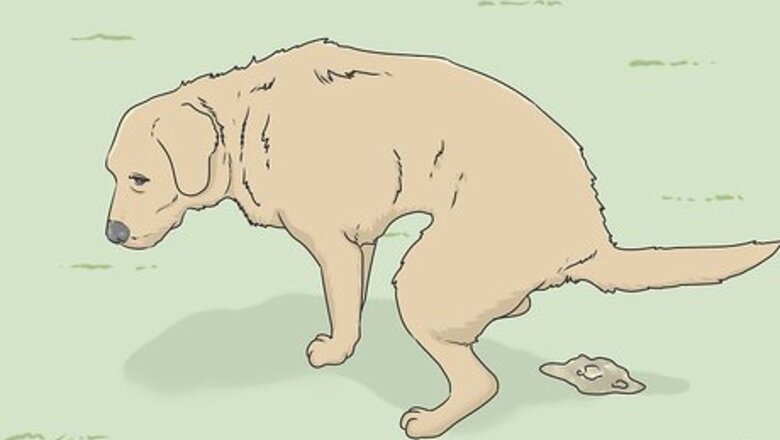
views
X
Trustworthy Source
American Kennel Club
The American Kennel Club (AKC) is a purebred dog pedigree registry in the United States. The AKC advocates for the responsible ownership of dogs and promotes purebred dog events, such as the Westminster Dog Show.
Go to source
Getting Veterinary Treatment
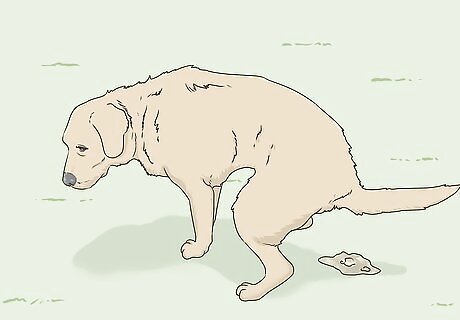
Spot the signs of a giardia infection. If your dog is ill, determine whether it has been somewhere where it could have been exposed to the parasite and if its symptoms are common with giardia. If you have seen your dog drink water in nature or from a bowl shared with other dogs, or it has had close contact with another dog's feces, it could have gotten giardia that way. Giardia symptoms can include: Watery, foul-smelling diarrhea Weight loss Inability to gain weight Lethargy Vomiting Dehydration Poor coat appearance
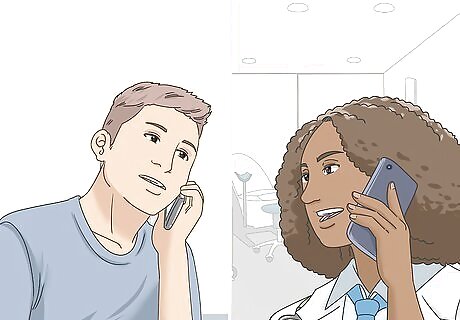
Call your veterinarian to see if your dog needs to be seen right away. Describe your dog's symptoms to your vet, including how long they have been occurring and how extreme they are. With this general information, your vet will make a suggestion about how quickly your dog needs to be seen. In some cases, your vet may tell you to bring your dog in immediately. If they tell you to do this, it means that your dog's health is in danger and it needs medical help right away. The main risk to your dog’s health is dehydration and loss of nutrients due to diarrhea or vomiting. Some dogs may be more at risk than others because of their age, overall health, or the severity of their symptoms. For example, a puppy is more likely to become dehydrated quickly from diarrhea than an otherwise healthy adult dog.
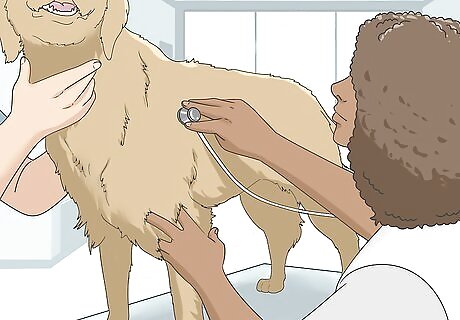
Allow your veterinarian to do diagnostic tests. When you bring your dog in to the vet, they will do a physical exam of your dog and ask you questions about its condition. If they suspect giardia, they need to run tests on your dog to confirm it. In most cases, your vet will ask for a feces sample, which will be tested for the parasites. Warning: The fecal giardia test is only 70% effective at detecting the giardia parasite. So if your dog tests negative, there is still a chance that they could have giardia and your vet may ask to do yet another fecal test. When you call in to consult with the veterinarian, the vet may tell you to bring in a feces sample. To reduce the risk of a false negative, your vet may ask for a “pooled” fecal sample. This means that you’ll need to collect 3 fecal samples from 3 separate days in the same container. This will increase your chances of getting a sample that contains some of the parasites.

Get prescription medication from your veterinarian. In most cases, your veterinarian will prescribe your dog fenbendazole or metronidazole to eliminate the giardia parasites. The veterinary office will provide the medication for you once it is prescribed. You need to give your dog medication to get rid of the giardia. This infection cannot be eliminated with home remedies. In some cases, your dog may even be prescribed a combination of both fenbendazole and metronidazole, especially if one or other has not been effective.
Giving Supportive Care at Home
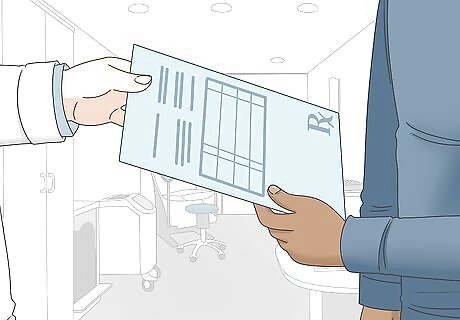
Follow your veterinarian's dosing directions closely. Once you bring your dog home, be sure to give your dog the medication you were sent home with at the times you were told to give it. The drugs used to treat giardia are normally given for 3 to 10 days, depending on the severity of the infection and the strength of the specific medication you are given. Even if your dog's symptoms disappear before the prescription is finished, keep giving your dog the medication. This will help ensure that all of the parasites are eliminated.Tip: In most cases, it's easiest to give your dog medication by sticking it in its food or in a treat. There are even specialty treats that are designed to conceal a pill inside of them.
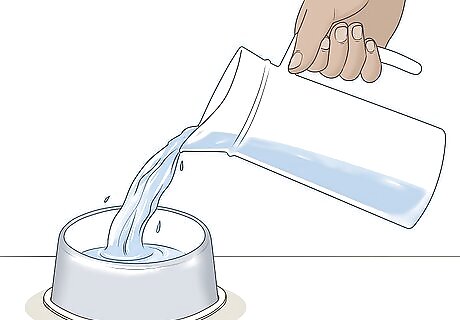
Provide water at all times to fight dehydration. The diarrhea and vomiting that is common with a giardia infection can cause your dog to become severely dehydrated very quickly. To fight this, give your dog access to clean water all of the time and encourage it to drink whenever possible. Your veterinarian may even suggest giving your dog an electrolyte-enhanced fluid, such as Pedialyte, if it is very dehydrated. However, this is only effective once the dog stops actively vomiting.
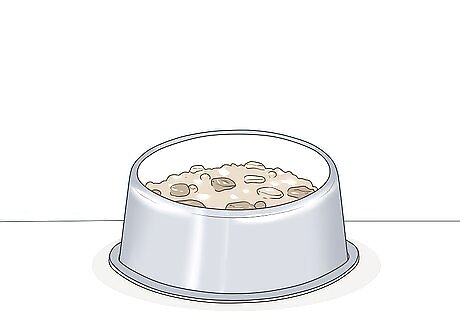
Feed your dog an easily digestible diet while it is healing. Since diarrhea is a very common symptom of giardia, feed your dog a diet that will help minimize it. For example, you can give your dog a mixture of cooked white rice and cooked boneless, skinless chicken in the same amount as you would normally feed it kibble or wet food. This mixture will be easy for your dog to digest and will help the diarrhea subside. Talk to your vet about what you should be feeding your dog while it is recovering from its infection.
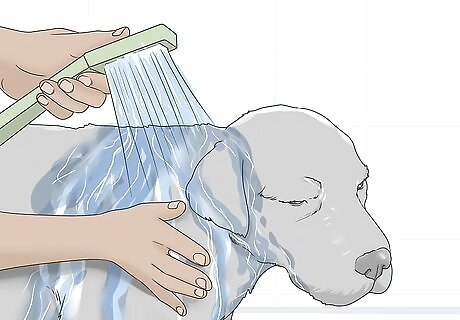
Bathe your dog at the end of treatment to remove any remaining parasites. Put on rubber gloves and then put your dog in a bathtub. Fill the tub with a few inches of warm water and then start lathering up your dog with dog shampoo. Clean the dog's rear end last, making sure to rinse the area around the anus thoroughly. After you have used your gloved hands to lather and rinse the dog's rear end, don't touch the rest of the dog’s body with your gloves. Take them off and handle the front of your dog with clean hands or new gloves.
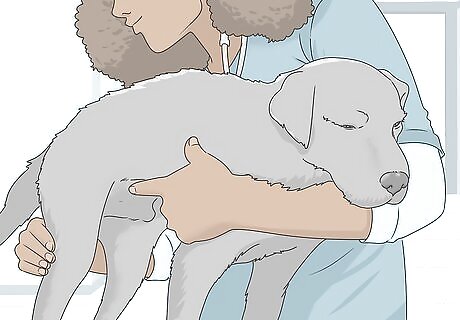
Take your dog in for a follow-up exam 2-4 weeks after treatment. Once you have given your dog all of its medication and it appears to be on the mend, it's important to get a clean bill of health from your vet. In most cases your vet will schedule the follow up appointment at the time of the initial exam. However, call the clinic during treatment to schedule the follow-up appointment if you don't have one scheduled already. During the follow-up exam your vet will typically do another fecal exam to ensure that the parasites are gone. You may need to collect a pooled sample (a combined sample with feces gathered over a few days) to ensure that the parasite has really been eliminated.
Preventing Reinfection and Spreading the Disease
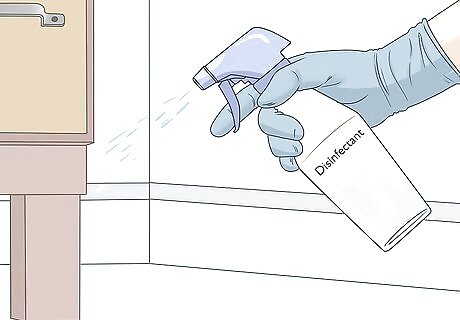
Disinfect all hard surfaces with a disinfecting solution. Clean all surfaces that your dog comes into contact with by putting on rubber gloves, spraying the surfaces with a disinfectant, and then leaving it on for 5–20 min before wiping it off. Surfaces that need to be cleaned include floors, the bottom of cabinets, hard furniture, and walls that your dog rubs up against. To make a homemade disinfecting solution, stir 1–2 cups (240–470 mL) of bleach into 1 gallon (3.8 L) of water. This can then be put into a spray bottle and used to clean indoor and outdoor surfaces.Tip: Do this thorough cleaning several times, ideally daily, while your dog is undergoing treatment. This will ensure that the dog doesn't get exposed to the parasite again.
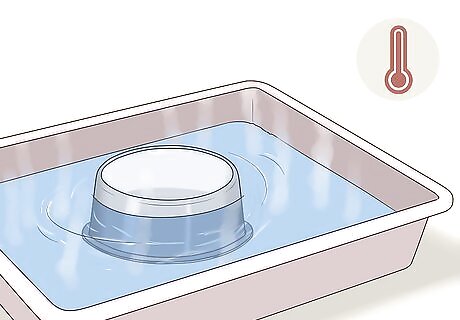
Sterilize all your dog-related items in the dishwasher, if possible. Place all food dishes, leashes, toys, and other items that are heat and water safe in the dishwasher. Set the machine to its hottest and longest cycle and run it to effectively kill the giardia parasites. If you don't have a dishwasher, you can clean these items by soaking them in boiling water for 5-20 minutes. Make sure that you are running these items in the dishwasher by themselves, not with your dishes.
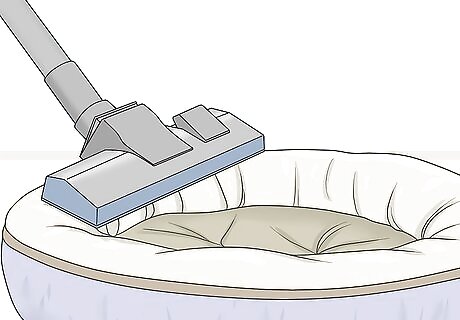
Clean all fabrics in a washing machine or with a steam cleaner. Take all fabrics that are machine washable and run them through the hot cycle of your machine. The linens that can be washed typically include blankets, small dog beds, bed linens, and clothes that the dog wears. All other fabrics that your dog has contact with, including furniture and carpets, should be steam cleaned to kill all of the parasites. This should be done at several points during your dog's recovery. Do a big cleaning right as you start treatment, midway through, and after the vet has verified that the infection is gone. Wash your hands after handling all of the linens, as you don't want to cross contaminate other surfaces or items.
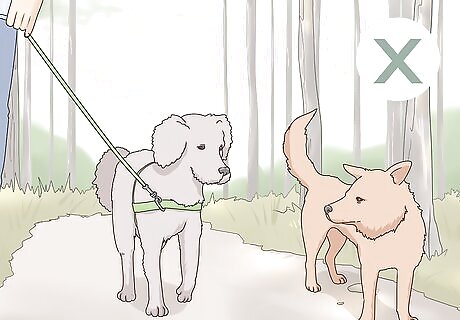
Keep your dog away from other dogs. Your dog can pass on its infection very easily if it comes into contact with other dogs. Don't take your dog to the dog park or to the groomers. Also, don't let it interact with your neighbor's dogs. Keep it sequestered until you have gotten the all clear from your vet. If another dog goes to smell your dog's rear end, pull your dog away. This is a quick and common way that the infection can be spread. If you have multiple dogs in your home, you may not be able to keep the dogs totally isolated from one another. If this is the case for you, your vet may suggest giving all of your dogs treatment at the same time.
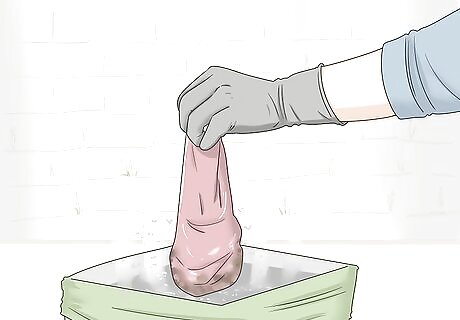
Clean up all feces quickly and completely. As your dog is recovering, supervise its bathroom time closely. This will allow you to know exactly where the dog is going to the bathroom so that you can remove the feces. Put on gloves and pick up the feces right away, seal it in a bag, and put the bag directly into your trash can. Even if your dog is the only dog that goes to the bathroom in your yard, the feces can reinfect your dog after the treatment is complete. If your dog has to go to the bathroom in a public place, carry a spray bottle of bleach solution to spray on the area after you pick up the feces. This disinfects the area so that no other dog gets infected. Tip: To make sure that you can clean up your dog's feces effectively, have it go to the bathroom on a concrete surface instead of grass. This will allow you to pick up the feces and then disinfect the surface completely.

















Comments
0 comment